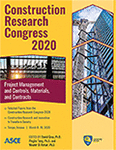Construction Research Congress 2020
Automated Design Information Extraction from Construction Specifications to Support Wood Construction Cost Estimation
Publication: Construction Research Congress 2020: Project Management and Controls, Materials, and Contracts
ABSTRACT
In achieving full automation of construction cost estimation, the complete processes involved in computing cost estimates must be automated. The typical processes involved in achieving cost estimates are: (1) classification and matching of model elements to their various categories; (2) taking off quantities from design documents or building information models; (3) retrieving unit cost from a cost database; and (4) applying the unit costs and quantities in computing the cost estimate. Although, the level of automation in quantity takeoff has been relatively high, most commercial software programs still require manual inputs from estimators to: (1) match materials of building elements to work items; and/or (2) fulfill essential information requirements that may be missing from design models for accurate cost estimate computations. These missing information are usually obtained from the construction specifications in supplement to the design models. Automating the process of design information extraction from construction specifications can help reduce: (1) the time and cost of the estimation, (2) the manual inputs required in cost estimation computations, and (3) human errors in cost estimates. This paper explores the use of natural language processing techniques to help process construction specifications and the authors propose a new algorithmic method for extracting the needed design information from construction specifications to support wood construction cost estimation. A case study was conducted on a wood construction project to evaluate the authors’ proposed method. The results showed that the proposed method successfully searched for and found design details from construction specifications to fulfil essential information requirements for detailed wood construction cost estimation, with a 94.9% precision and a 97.4% recall.
Get full access to this article
View all available purchase options and get full access to this chapter.
ACKNOWLEDGMENTS
The authors would like to thank the National Science Foundation (NSF). This material is based on work supported by the NSF under Grant No. 1745374. Any opinions, findings, and conclusions or recommendations expressed in this material are those of the authors and do not necessarily reflect the views of the NSF.
REFERENCES
Akanbi, T., and Zhang, J. (2017). “Automated wood construction cost estimation” Proc., 2017 ASCE Intl. Workshop on Comput. in Civ. Eng., ASCE, Reston, VA., 141-148.
Afsari, K., and Eastman, C. (2016). “A Comparison of Construction Classification Systems Used for Classifying Building Product Models” Proc., 2016 ASC Annual International Conference, Denver, CO., 101-108.
Autodesk. (2017). “Classification Systems and Their Use in Autodesk Revit: Managing the “I” in BIM.” https://www.biminteroperabilitytools.com/classificationmanager/downloads/Autodesk%20Whitepaper%20-%20Classification%20Systems.pdf (April 12, 2019).
BIMForum. (2017). “Level of development specification guide: November 2017.” https://bimforum.org/wp-content/uploads/2017/11/LOD-Spec-2017-Guide_2017-11-06.pdf (Apr. 10, 2019).
Charette, R., and Marshall, H. (1999). “Uniformat II Elemental Classification for Building Specifications, Cost Estimating, and Cost Analysis.” National Institute of Standards and technology (NIST).
Cherpas, C. (1992). “Natural language processing, pragmatics, and verbal behavior.” Analysis of Verbal behavior, 10,135-147.
Choi, J., Kim, H., and Kim, I. (2015). “Open BIM-based quantity takeoff system for schematic estimation of building frame in early design stage.” Journal of Computational Design and Engineering, 2(2015), 16-25.
CSI. (2012). MasterFormat. https://www.edmca.com/media/35207/masterformat-2016.pdf (July 22, 2019).
Grishman, R. (2010). Information Extraction. The Handbook of Computational Linguistics and Natural Language Processing. Wiley-Blackwell, United Kingdom, 515–530.
Kaiser, K., and Miksch, S. (2005). “Information Extraction: A survey.”
Kim, T., and Chi, S. (2019). “Accident Case Retrieval and Analyses: Using Natural Language Processing in the Construction Industry.” J. Constr. Eng. Manage., 2019, 145(3): 04019004.
Lee, S., Kim, K., and Yu, J. (2014). “BIM and ontology-based approach for building cost estimation.” Automation in Construction, 41(2014), 96-105.
Ma, Z., Liu, Z., and Wei, Z. (2016). “A generic feature-driven activity-based cost estimation process.” Advanced Engineering Informatics, 17(2003), 96-105.
Nassar, K. (2012). “Assessing building information modeling estimating techniques using data from the classroom.” Journal of Professional Issues in Engineering Education & Practice, 138(2012), 171-180.
Shou, W., Wang, J., and Wang, X. (2015). “Formalized Representation of Specifications for Construction Cost Estimation by Using Ontology.” Computer-Aided Civil and Infrastructure Engineering,31(2016), 4-17.
Staub-French, S., Fischer, M., Kunz, J., and Paulson, B. (2003). “A generic feature-driven activity-based cost estimation process.” Advanced Engineering Informatics, 17(2003), 96-105.
The General Services Administration (GSA). (2017). “PBS-P100: Facilities Standards for the Public Buildings Service.” https://www.gsa.gov/cdnstatic/2017_Facilities_Standards_%28P100%29%C2%A0.pdf (April 14, 2019).
Zhang, J., and El-Gohary, N. (2016). “Semantic NLP-based information extraction from construction regulatory documents for automated compliance checking.” J. Comput. Civ. Eng., 2016, 30(2): 04015014
Zhang, J., and El-Gohary, N. (2017). “Integrating semantic NLP and logic reasoning into a unified system for fully-automated code checking.” Automation in Construction, 73, 45-57.
Information & Authors
Information
Published In
Construction Research Congress 2020: Project Management and Controls, Materials, and Contracts
Pages: 658 - 666
Editors: David Grau, Ph.D., Arizona State University, Pingbo Tang, Ph.D., Arizona State University, and Mounir El Asmar, Ph.D., Arizona State University
ISBN (Online): 978-0-7844-8288-9
Copyright
© 2020 American Society of Civil Engineers.
History
Published online: Nov 9, 2020
Authors
Metrics & Citations
Metrics
Citations
Download citation
If you have the appropriate software installed, you can download article citation data to the citation manager of your choice. Simply select your manager software from the list below and click Download.
